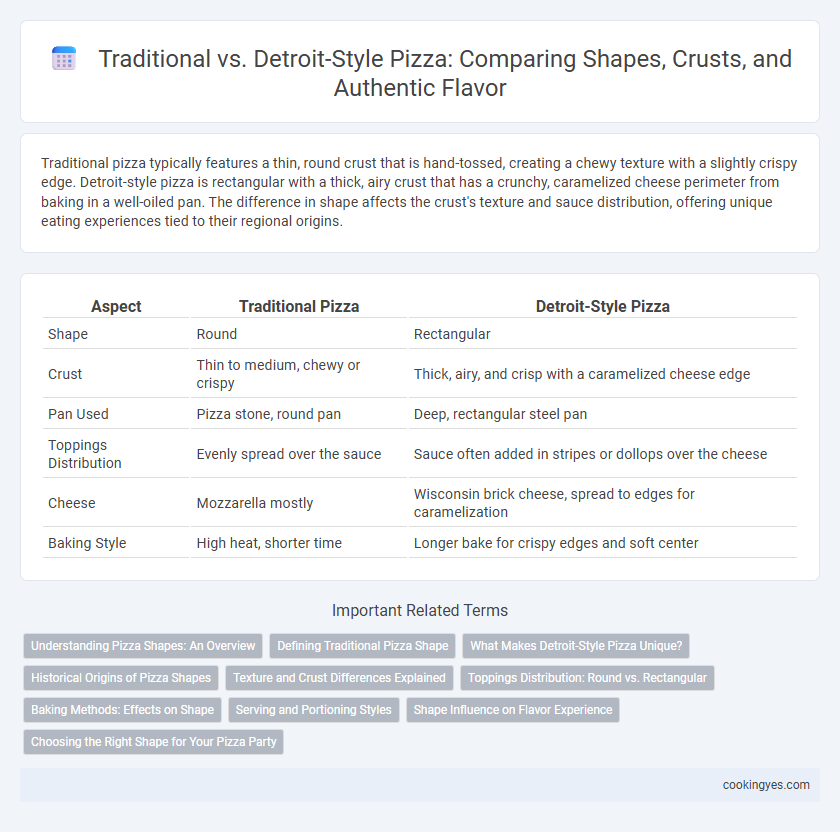Traditional pizza typically features a thin, round crust that is hand-tossed, creating a chewy texture with a slightly crispy edge. Detroit-style pizza is rectangular with a thick, airy crust that has a crunchy, caramelized cheese perimeter from baking in a well-oiled pan. The difference in shape affects the crust's texture and sauce distribution, offering unique eating experiences tied to their regional origins.
Table of Comparison
| Aspect | Traditional Pizza | Detroit-Style Pizza |
|---|---|---|
| Shape | Round | Rectangular |
| Crust | Thin to medium, chewy or crispy | Thick, airy, and crisp with a caramelized cheese edge |
| Pan Used | Pizza stone, round pan | Deep, rectangular steel pan |
| Toppings Distribution | Evenly spread over the sauce | Sauce often added in stripes or dollops over the cheese |
| Cheese | Mozzarella mostly | Wisconsin brick cheese, spread to edges for caramelization |
| Baking Style | High heat, shorter time | Longer bake for crispy edges and soft center |
Understanding Pizza Shapes: An Overview
Traditional pizza typically features a circular shape with a thin to medium crust, allowing for even cooking and classic foldable slices popular in New York-style pizza. Detroit-style pizza is rectangular, characterized by its thick, airy crust with crispy edges created by baking in a well-oiled steel pan, which enhances caramelization and texture. Recognizing these distinctive shapes helps diners appreciate differences in crust texture, cooking techniques, and overall eating experience.
Defining Traditional Pizza Shape
Traditional pizza shape is typically round with a thin to medium crust, characterized by a uniform thickness and a slightly raised edge forming a crust. It is baked on a flat, circular pan or stone, allowing for an even distribution of toppings and a chewy but crisp texture. This classic form emphasizes a balance between a tender interior and a browned, slightly crunchy exterior.
What Makes Detroit-Style Pizza Unique?
Detroit-style pizza is uniquely characterized by its rectangular shape and thick, airy crust with a crispy, caramelized cheese edge created by baking in a well-oiled steel pan. This style contrasts with traditional round pizzas, emphasizing a chewy interior and a crispy exterior that holds up well to generous toppings and a distinctive, often layered tomato sauce. The use of Wisconsin brick cheese, which melts evenly and creates a signature crispy edge, further distinguishes Detroit-style pizza from traditional varieties.
Historical Origins of Pizza Shapes
Traditional pizza, originating from Naples, Italy, features a round shape with a thin, foldable crust designed for easy handling and quick baking in wood-fired ovens. Detroit-style pizza, developed in the mid-20th century, is rectangular with a thick, airy crust, baked in steel trays that create a crispy, caramelized cheese edge. These distinct shapes reflect their historical and regional baking techniques, influencing texture, flavor, and serving style.
Texture and Crust Differences Explained
Traditional pizza features a thin, crisp crust with a tender interior, creating a balanced texture that complements various toppings. Detroit-style pizza is characterized by its thick, airy crust with a chewy, soft center and a caramelized, crispy edge from being baked in a rectangular steel pan. The contrast in crust thickness and texture between these styles defines their unique eating experiences, with Detroit-style offering a more substantial bite and traditional pizza providing a lighter, crunchier base.
Toppings Distribution: Round vs. Rectangular
Traditional pizza features a round shape with toppings evenly spread from the center to the crust, ensuring a balanced flavor in every slice. Detroit-style pizza uses a rectangular shape, with toppings distributed more densely and often layered beneath a thick, crispy crust that allows for richer, concentrated flavor pockets. The rectangular pan shape of Detroit-style pizza promotes caramelization along the edges, contrasting with the uniform topping distribution of round traditional pizzas.
Baking Methods: Effects on Shape
Traditional pizza baking typically uses high-temperature stone ovens that promote a thin, crispy crust with a round shape due to even heat distribution and direct contact with the stone surface. Detroit-style pizza is baked in a rectangular steel pan, where the dough rises and caramelizes against the oiled edges, creating a thick, airy crust with a distinct square shape. The differences in heat conduction, pan material, and oven type directly influence the final texture, crust thickness, and geometric form of each style.
Serving and Portioning Styles
Traditional pizza is typically round and sliced into triangular portions, allowing for easy hand-held serving and sharing among groups. Detroit-style pizza features a rectangular shape with thick, airy crusts, often cut into square or rectangular slices that emphasize a hearty, substantial serving size ideal for communal dining or casual meals. The shape and portioning style of Detroit pizza reflect its roots as a practical, filling dish designed for sharing, contrasting with the more standardized triangular slices of traditional pizza.
Shape Influence on Flavor Experience
Traditional pizza features a thin, round shape that promotes a crispy crust and balanced topping distribution, enhancing the classic flavor profile with each bite. Detroit-style pizza is rectangular with a thick, airy crust that creates a chewy texture and caramelized edges, intensifying the savory and cheesy flavors. The distinct shapes directly influence the texture contrast and flavor intensity, shaping the overall sensory experience of the pizza.
Choosing the Right Shape for Your Pizza Party
Traditional pizza typically features a round shape with a thin, hand-tossed crust that crisps evenly, ideal for easy slicing and sharing at casual gatherings. Detroit-style pizza is distinguished by its rectangular shape and thick, airy crust with crispy, caramelized edges, perfect for a hearty, satisfying option that can serve larger groups. Selecting between these shapes depends on the desired serving style and crust preference, ensuring your pizza party caters to guests who favor classic simplicity or bold, robust textures.
Traditional vs Detroit-style for pizza shape Infographic

 cookingyes.com
cookingyes.com